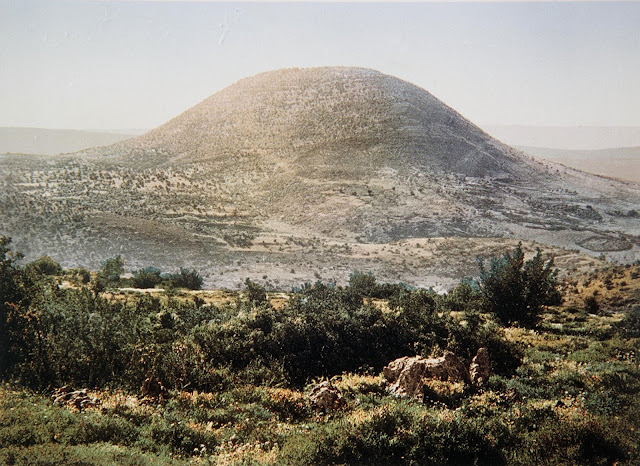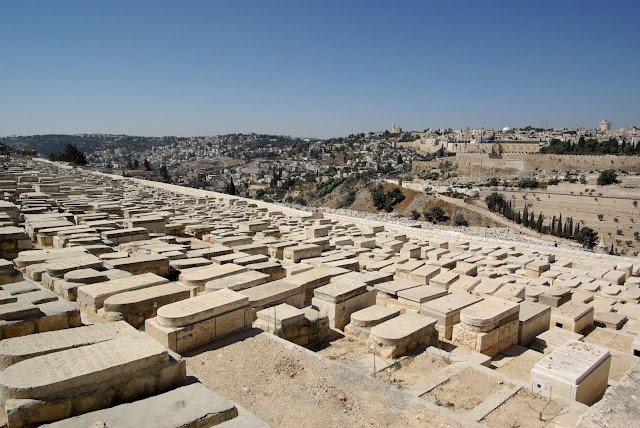The Bible, ancient
historians and the Geological Society of America all indicate that an
earthquake hit Jerusalem when Jesus died.
According to the
Gospel of Matthew an earthquake hit Jerusalem when Jesus died and produced
damage in the temple area:
Matthew 27:50 “And Jesus
cried out again with a loud voice, and yielded up his spirit. 51 And behold,
the veil of the temple was torn in two, from top to bottom. And the earth
shook. And the rocks were split.”
The earthquake at
Jesus’ Crucifixion is potentially confirmed in the Jewish Talmud. According to
the Talmud[Shabbat 15a], the Sanhedrin was exiled or banished from the
subterranean chamber in the temple complex 40 years before the temple was
destroyed. The passage in the Talmud also indicates this coincided with the
Sanhedrin no longer adjudicating capital cases. The gospels indicate that the
Jewish leadership was involved with the capital case against Jesus that
occurred approximately 40 years before the temple destruction was completed. So
according to the Talmud, Jesus’ trial may have been the last or one of the last
capital cases involving the Sanhedrin. The subterranean structure where the
Sanhedrin met was abandoned afterwards possibly due to earthquake damage that
sealed it off from access or made it unsafe.
The Jewish Talmud[Yoma
39B] provides a second clue pointing toward earthquake damage in Jerusalem at
the time of Jesus’ death. The temple doors began opening by themselves 40 years
prior to the destruction of the temple. This indicates that something happened
to the architectural supports for the temple doors at the time of Jesus’ death.
An earthquake could’ve damaged the angularity of the door supports so that they
began opening on their own.
There are
non-Jewish sources that also indicate an earthquake hit the region near
Jerusalem at approximately the time of Jesus’ death:
“Phlegon stated
that in the 19th year of Tiberius (as Eustathius Antiochus noted in Hexaemeron)
and the fourth year of the 202nd Olympiad (that is 33 AD), the following events
took place... 'There was the largest and most famous eclipse that had ever
occurred. The day was so turned into night at the sixth hour (noon), that the
stars were seen. Also, an earthquake in Bithynia destroyed many houses in the
city of Nicaea” (James
Ussher, Annals of the World 6503).
“[t]he largest
earthquake happened in the principate of Tiberius Caesar when twelve cities in
Asia Minor were razed to the ground in one night” (Pliny's Natural History 38).
The Geological
Society of America Jerusalem earthquake of 33 A.D.: Evidence
within laminated mud of the dead sea, Israel (Austin, Steven A.) -
Two thousand years ago the Dead Sea Basin was shaken by two earthquakes that
left two widespread seismites within laminated Dead Sea sediment. The first
earthquake (spring 31 B.C., Jericho fault, M~7.2) transformed adjacent Dead Sea
laminated mud and aragonite into a persistent and distinctive intraclast
breccia seismite in places greater than 1 m thick. The 1st-century Jewish
historian Josephus described the 31 B.C. earthquake as a significant social and
economic event during King Herod's reign. A second seismite occurs within
laminated mud and aragonite at 10 to 85 cm above the 31 B.C. seismite. Varve
counting above the 31 B.C. datum indicates the second seismite can be assigned
to 31 A.D. (+/- 5 years), but history specifies as 33 A.D. Superb mud laminae
exposures are provided in two gullies at the southwest corner of the Dead Sea
at Wadi Ze'elim fan delta where the 33 A.D. seismite outcrops 55 to 85 cm above
the 31 B.C. intraclast breccia. The 33 A.D. seismite at Ze'elim is
intraformationally folded, 8-cm-thick, sometimes brecciated, silicate mud and
aragonite/gypsum laminae. Seismite facies progress from "linear
waves" to "asymmetric billows" to "breccia" expressing
transition to Kelvin-Helmholtz turbulence within the uppermost shearing laminae
during shaking. Recumbent folds and imbricate faults are consistent with
gravity collapse upon a broad arch structure during shaking. Folded seismite
transitions northward within fan deltas to thicker intraclast breccia,
suggesting an epicenter nearer Jerusalem. Matthew, the 1st-century synoptic
Gospel author, reported two earthquakes in Jerusalem in 33 A.D. These are the
Jerusalem earthquakes of April 3 at the crucifixion of Christ (Matt. 27:51),
and April 5 at the resurrection of Christ (Matt. 28:2). Luke, a first century
physician and historian, reported a smaller earthquake in the summer at the
gathered assembly (Acts 4:31). The persistent 33 A.D. seismite indicates the
biggest 33 A.D. earthquake was M~6.0. This biggest earthquake was likely April
3, 33 A.D. that startled city residents and caused moderate damage, especially
to the western side of Temple Mount. Pivots of two, 20-m-high, metal doors of
the Temple appear to have been damaged, and the 20-m-high curtain in front of
the doors was torn, likely by displacement of the lintel of the Temple during
the earthquake.
If an earthquake
damaged the temple in Jerusalem at the time that Jesus died, the population of
that city would’ve viewed this as a portent with supernatural overtones. This
would explain why the Sanhedrin stopped adjudicating capital cases after the
crucifixion of Jesus.
Dr. J. Clontz,
Aidan University – Editor of The Comprehensive New Testament
Shabbat
15a – “Forty years before the Temple was destroyed, the Sanhedrin was exiled
from the Chamber of Hewn Stones and sat in the stores on the Temple Mount. With
regard to the last statement, the Gemara asks: What are the halakhic
ramifications of this statement? Rabbi Yitzḥak bar Avdimi said: To say that they no longer judged cases of
fines. The Gemara wonders: Does it enter your mind that they no longer judged
cases of fines? Even several generations after the Temple was destroyed they
continued to judge cases of fines in Eretz Yisrael. Rather, emend and say: That
they no longer judged capital cases. The authority to impose the death penalty
was stripped from the Sanhedrin, and therefore they willingly left the Chamber
of Hewn Stone. Since the Sanhedrin no longer convenes in its designated place,
the halakha is that it no longer has the authority to judge capital cases
(Tosafot).”
Yoma
39B – “The Sages taught: During the tenure of Shimon HaTzaddik, the lot for
God always arose in the High Priest’s right hand; after his death, it occurred
only occasionally; but during the forty years prior to the destruction of the
Second Temple, the lot for God did not arise in the High Priest’s right hand at
all. So too, the strip of crimson wool that was tied to the head of the goat
that was sent to Azazel did not turn white, and the westernmost lamp of the
candelabrum did not burn continually. And the doors of the Sanctuary opened by
themselves as a sign that they would soon be opened by enemies, until Rabban Yoḥanan ben Zakkai scolded them. He said to the Sanctuary: Sanctuary,
Sanctuary, why do you frighten yourself with these signs? I know about you that
you will ultimately be destroyed, and Zechariah, son of Ido, has already
prophesied concerning you: “Open your doors, O Lebanon, that the fire may
devour your cedars” (Zechariah 11:1), Lebanon being an appellation for the
Temple.”










